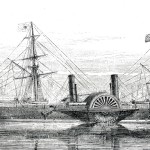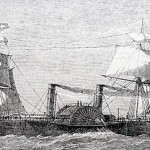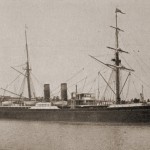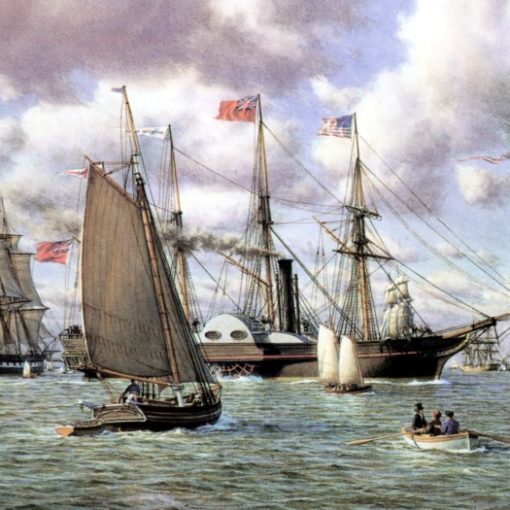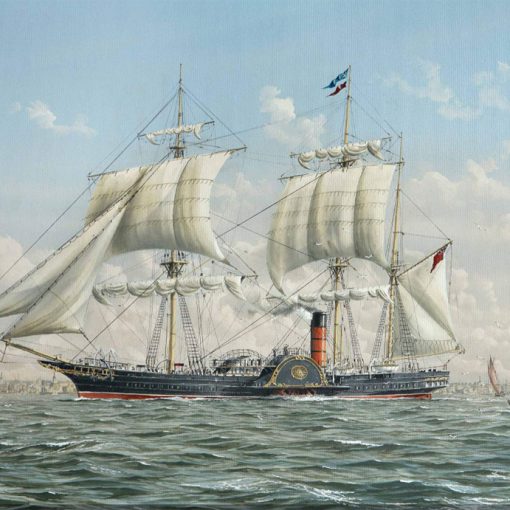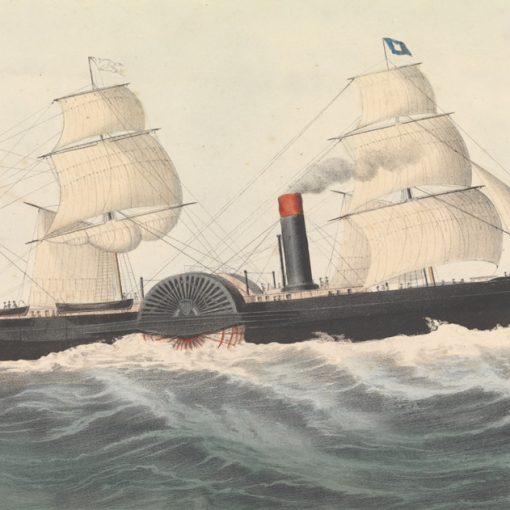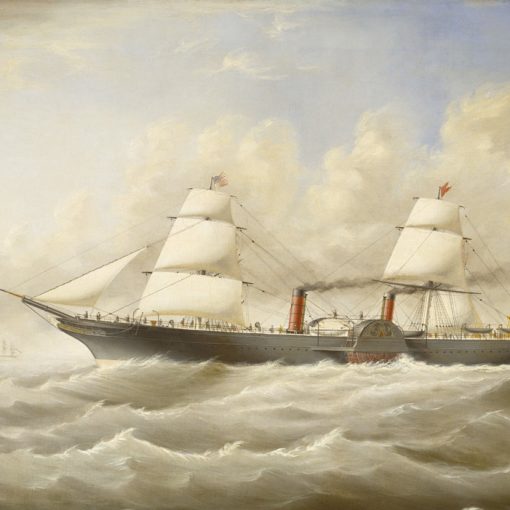1864 – 1899
When looking back at the 20th century, there are a few shipping companies that stand out as more prominent that others. The French Line – or the Compagnie Générale Transatlantique (CGT) – is undoubtedly one of those companies. During its lifetime, this shipping line became famous for its marvellous cuisine, ambience and not to mention its fantastic ships. Such wonderful creations like Île de France, Normandie and the third France made up the very best the French Line had to offer, but the story of this fabled company had started already back in the mid-1850s.
Founded in 1854 by the two brothers Émile and Isaac Péreire, the company was first known as the Compagnie Générale Maritime. In 1861, the mail-carrying steamship side of the company was renamed Compagnie Générale Transatlantique, and Isaac’s son Eugene Péreire was appointed President.
The French government was eager to see a competitive French shipping line on the North Atlantic, and therefore granted CGT a mail contract for one sailing per month. The company’s directors saw this as a perfect opportunity to expand the business, and eight identical new ships were commissioned for the transatlantic trade. The French Ministry of Marine wanted all of the new ships to be built in France, but the country did not yet have sufficient capacity for this. So, three ships were ordered from the Glasgow yards of John Scott & Co. The remaining five were to be built at the French Chantiers de l’Atlantique, at St Nazaire, though under direction of John Scott & Co. On October 21st, the contract for the three first ships was signed.
Work soon began on the new ships. They were designed by John Scott & Co., under supervision of the French engineer Éugene Flachat, to compete with Cunard’s Persia – holder of the Blue Riband at the time. Accordingly, they were designed with paddle wheels, just as Cunard’s champion. CGT had also made it clear that they wanted sturdy ships, and for this the new ships were constructed with their frames a mere 20 inches, or 50 centimetres, apart. At a little more than 3,000 gross tons, the size of the new ships was constricted by the capacity of the docks at Le Havre.
Twenty months later, the first of the eight new ships was ready for her launch. On June 17th 1863, she was given the name Washington, and sent down the ways to enter the water for the very first time. The launch was a success, and the work on fitting the ship out could soon begin. When finished, the Washington was to go through her sea trials before entering commercial service. These turned out completely satisfactory, and the new ship had managed to achieve a speed of 13.3 knots. At the time, Cunard’s Persia and Scotia ruled the North Atlantic with a service speed of 13.5 knots.
Almost a year to the day after her launch, the Washington was ready to set out on her premier crossing of the Atlantic Ocean. On June 15th 1864, the brand new vessel slipped her moorings and steamed out of Le Havre, bound for New York with 67 passengers on board. This was to become the company’s prime route for more than a century.
Outwardly, the ship bore the typical appearance of her day. Although a steamship, one could still make out a resemblance to the sailing vessels of old. Her two masts were capable of taking sails – with a total sail area of 1,885 square feet – should the engines fail to work properly. There was not much of a superstructure, and the bridge was just that – a simple bridge between the two paddle wheels. Nevertheless, just 15 feet shorter than Cunard’s Persia, the Washington must have been an impressive sight. On the inside, every effort had been made to provide the passengers with as comfortable a ship as possible. This ship, and her sisters, was soon to set a French standard for good food and comfort.
The maiden voyage continued for the following 13 ½ days, and the ship arrived in New York harbour on June 28th, having averaged a speed of 13 knots and consumed 125 tons of coal each day. The French transatlantic run was born. Yet there had been a few disappointments. John Scott & Co. had built the Washington with open deck rails. But the North Atlantic can be treacherous, and CGT decided to fit the ship with solid bulwarks. This was done after only a few voyages.
And so, the Washington settled into her service for CGT, becoming more and more acquainted with the swell of the Atlantic. However, on October 26th 1864 she suffered a serious mishap when she collided with a Dutch sailing vessel off Alderney. Following this incident, she was forced to put into Cherbourg instead of Le Havre.
The year of 1868 came to hold an important event for the Washington. Although it had been the matter of discussion and speculation for more than two decades, it had by now been more or less proven that the propeller was superior – and far more economical – than the conventional paddle wheels. With this is mind, CGT made the major decision to progressively have their fleet converted. Consequently, Washingtonwas sent to the Glasgow yards of Robert Napier & Sons to be rebuilt with propellers.
The ship’s original engines were replaced with two new two-cylinder single expansion engines, geared to twin propellers. In April that year she re-emerged with a slightly higher gross tonnage of 3,408 tons. The refit had changed the ship’s looks dramatically, with a more accentuated superstructure and a modern bridge. A mizzen mast had also been added to improve her sailing capabilities, which goes to testify that the world did not yet fully trust the steam engine. Actually, with this refit the Washington became the first twin-screw liner on the North Atlantic. This honour is often erroneously given to the Inman & International liner City of New York – which was ‘only’ the first transatlantic ship that was originally built with two propellers.
On May 16th 1868, the Washington was back in service, but by now she had been transferred to CGT’s St Nazaire-West Indies run. She remained on this route until October 1871, when she was put back on the North Atlantic to fill the gap of her sister, Lafayette, which had been damaged by fire at Le Havre. The new type of propulsion gave her a service speed of 13.75 knots, burning only 110 tons of coal per day.
During the winter of 1872-1873, Washington was taken in to have her machinery renewed. This refit resulted in her being more economic to operate, but it also gave her a slower service speed of only 11 knots. In June of 1874 she resumed her sailings to New York, but there was a novelty in her itinerary. From now on, she was put on the West Indies run in the winter season. This work continued through the following nine years, and in 1883 the Washington was once again sent to go through a refit, this time to be modernised at Chantiers.
In 1888, Washington was reverted to CGT’s St Nazaire-Colon service. But the company still saw it as meaningful to invest in her, and she was fitted with electric lighting during one of her overhauls. Two years later, the ship suffered an unnecessary accident. While at her dock at St Nazaire, someone had left a valve open. The ship took on water and settled on the bottom. The ship was pumped dry and saved.
In December of 1896, the now ageing Washington was given new boilers. Not brand new though; this set of boilers had been taken from the Lafayette, which had been refitted with triple-expansion engines a few years ago. By the next summer, the ship was back in service at St Nazaire. But, as history would have it, her end was nigh. In February of 1899, while leaving Penhoët, she hit a swing bridge as it opened for her exit. Although the swing bridge was the one who took the most damage by the collision, this may have marked the beginning of the end for the old Washington. In December that year, she was sold for 320,000 French Francs to scrappers at Marseilles, and she was cut up the following year.
Specifications
- 345 feet (105.4 m) long
- 43 feet (13.1 m) wide
- 3,204 gross tons originally, 3,408 tons after 1868
- 2 x 1 cylinder simple expansion engines. Originally fitted with paddle wheels. Engines renewed and geared to two propellers during the 1868 refit.
- 13 knot service speed
- Passenger capacity of 211 people

